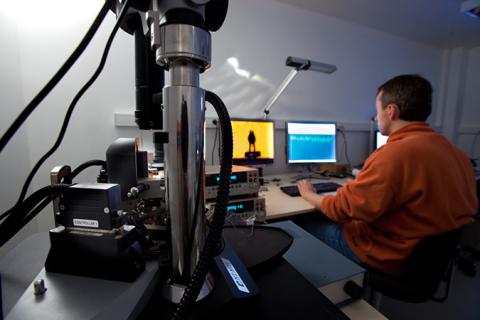Micro and nanoscale heat transfer
Context
Nanotechnologies have led to the development of micro and nanostructured materials and systems, which are now ubiquitous. One of the many challenges is the control and improvement of their thermal performance. It happens that the physical laws (Fourier's law, macroscopic theory of thermal radiation, etc.) and metrological approaches used in heat transfer since decades are no longer valid at micro and nanoscale. Therefore, specific research must be conducted. This is the goal of the theme on MIcro and Nanoscale heat Transfer (MiNT).
Objectives
-
Understand, characterize and simulate heat transfer in micro and nanostructured materials and systems
-
Study thermal transport by heat conduction and radiation at micro and nano scales
-
Develop thermal metrology at micro and nanoscale, including thermal atomic force microscopy (scanning thermal microscopy, SThM) and electro-thermal experiments with deposited resistive sensors
-
Measure temperature and thermal and thermoelectric properties at submicron scale
-
Understand how heat transfer at these scales impacts energy-conversion devices such as thermophotovoltaic and thermoelectric converters
Scientific skills
-
Development of simulation tools to describe conduction heat transfer in micro- and nanostructured systems and materials (by implementing ballistic transport with the Boltzmann equation, phonon engineering approaches, molecular dynamics and ab initio models)
-
Development and / or implementation of electromagnetic models to describe radiative heat transfer at micro and nanoscale
-
Detailed physical analysis of nanoscale energy-conversion devices, including thermophotovoltaic cells
-
Implementation of local scanning thermal microscopy (SThM) for the measurement of temperature and thermal conductivity: application to bulk materials, thin films and micro and nanostructured materials; development of new modes of near-field microscopy for thermal studies; modeling and analysis of the heat exchange between the probe tip and the sample to improve the performance of the technique (sensitivity, resolutions, uncertainty);
-
Electrothermal and thermoelectric characterization of micro and nanostructured materials by methods involving deposited resistive sensors ("3-omega" and other methods), from cyogenic temperatures up to 500 °C.


Some international collaborations
VTT Technological Centre of Finland, Greater Helsinki (Finland); Czech Institute of Metrology (CMI), Brno (Czech Republic); University of Glasgow (United Kingdom); Aristotle University, Thessaloniki (Greece); Catalonian Research Institute for Energy (IREC), Barcelona (Spain); Tohoku University, Sendai (Japan); University of Utah, Salt Lake City (USA); Cinvestav Queretaro (Mexico); etc.
Some national collaborations
French networks on Nanomaterials for Energy (GDR NAME), on Nanomaterials Characterization & Measurements (GDR CarMa Nano) and on Thermal Radiation to Electrical Energy conversion (GDR TREE)
Scientific community devoted to Heat transfer at nanoscale (see Bluesky account)
Laboratory for Energy and Mechanics (LEMTA, Nancy), Néel Institute (Grenoble), Institute for Electronics and Microtechnologies (IEMN, Lille), Institute of Electronics and Systems (IES, Montpellier), National Metrology Institute of France (LNE, Paris region), Laboratory for Analysis and Architectures of Systems (LAAS, Toulouse), Institute for Thermal analysis, Materials and Mechanics (ITheMM, Reims), etc.
Local in Lyon: Institute for Light and Matter (ILM), Institute for Nanotechnologies of Lyon (INL), Laboratory of Mechanics of Contact and Structures (LamCos), Material's Interfaces and Surfaces Laboratory (MATEIS), ...
Recent industrial partnerships
Large companies: ST Microelectronics, Thales RT.
Small and Medium Businesses: CSI, PicoSun, NanoTest, Kelvin NanoTechnology, Conpart AS.
News
- 06/2024: Yersultan Rimkul gets the INSA Openlabs poster prize
- 12/2023: Sreyash Sarkar awarded a prize at the nanophotonics symposium of the MRS Fall 2023 conference
- 12/2023: Konstantinos Termentzidis to "Focus Sciences": The strange thermal behaviours of the nanoworld...
- 05/2023: Markos Poulos awarded a prize at the Phononics 2023 conference
- 05/2022: Sarah Douri awarded a best-poster prize at the Monacoste scientific school
- 12/2021: Stefan-Boltzmann's law is not valid at nanoscale
- 06/2021: Converting thermal radiation into electricity: a milestone is reached
- 12/2019: European project Quantiheat awarded a 'Star of Europe' prize by the French Ministry for Research
- 01/2019: Progress towards understanding of heat transfer in nanocomposites
Permanent personnel
LEFEVRE Stéphane (Assis. Prof. INSA)
MERCHIERS Olivier (Assis. Prof. INSA)
TERMENTZIDIS Konstantinos (DR CNRS)
Non-permanent personnel (as of 01/11/2025)
Master students, interns and short-time visitors at CETHIL are listed only in the Directory of the Centre.

